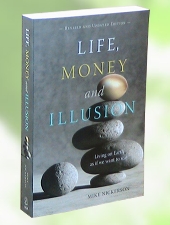The whole story:

Life, Money
and Illusion
A Key to the Future
However the future unfolds, long-term well-being will be rooted in the elemental processes illustrated in the 8-minute video: To Be Alive and Well; It’s Easier Than You Think.
When industry advanced to the point where it could eliminate human need, the choice was made to continue expanding by encouraging want. Since promoting consumption became a goal, our world has drifted increasingly away from neighbourly relations and toward acquisition and accumulation as personal objectives. While getting a new thing can provide a thrill, things don’t respond the way a friend does, leaving a vacuum in our hearts. With advertising constantly telling us to fill that vacuum with more things, we have mined, processed, consumed and thrown away enough of Earth’s natural resources to cause problems with both resource supplies and pollution.
Continuous expansion is no longer a viable goal. How then might societies evolve to thrive on this now full Earth?
To Be Alive and Well offers a starting point for thinking about possibilities. In particular, we encourage sharing it with young adults. A large portion of new discoveries have been made by young people: television, Braille, the calculator, earmuffs, Facebook, the snowmobile, and much more were invented by young adults. Einstein, Edison, Marie Curie, Alan Turing and Nicola Tesla all got their inspirations in early adulthood and worked from those initial insights throughout their lives.
Who better to innovate sustainable ways to live than today’s young? They have the imagination, energy, and vested interest in making the world work over the decades ahead. Indeed, in any age, young minds are developmentally ordered for solving the problems of the world they are growing into.
Have a look at To Be Alive and Well; It’s Easier Than You Think. Imagine what today’s youth might do with such insight. Please pass it along to young people you know and to schools and other institutions that work with young adults. We need young people to grasp the challenge.
In appreciation,
![]()
